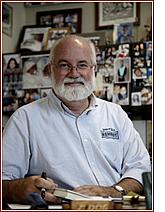Father Gregory Boyle: Preventing Gang Violence, Improving Community Health


"Gang violence points to lot of things that we haven't addressed well: a permanent underclass, poverty, the divide between rich and poor, racism, a lack of medical care, and despair, which is the absence of hope," he told National Health Journalism Fellows gathered in Los Angeles this week. "No one has met a hopeful kid who's joined a gang. No kid is seeking anything when he joins a gang, he's fleeing something."
Father Boyle started what would eventually become Homeboy Industries with a bakery that provided jobs, training and the opportunity for rival gang members to work alongside each other. Today, the nonprofit operates two cafés, a silk screening business and a solar panel installation training program.
Learning about gangs, race and violence may not seem like a traditional part of the health beat. Yet the concept of violence as a significant public health threat has been around for more than three decades.
The medical fallout from gang and other urban violence, particularly among teenagers and young adults, includes post-traumatic stress syndrome (PTSD), depression, suicide, self-injury, and of course the gunshot wounds and other physical injuries. Researchers increasingly are finding links between communities plagued by violence and the poor health of the people who live there.
I've previously written about the history of violence as a public health issue and tips from top journalists for covering urban violence and its health implications. Another great read from journalist and former California Health Journalism Fellow Beatrice Motamedi focuses on what she learned while reporting on youth violence and the resiliency of low-income teenagers in Oakland, California.
Here are some other resources for your reporting:
Exploring the Social Determinants of Health: Violence, Social Disadvantage and Health – issues brief from the Robert Wood Johnson Foundation
Prescribing Prevention to Treat Urban Violence – article from the journal Public Health Reports
Advancing State Efforts to Prevent Urban Violence – issues brief from the Prevention Institute
Tattoos on the Heart: The Power of Boundless Compassion – Father Gregory Boyle's 2010 book on preventing gang violence
Photo credit: Homeboy Industries
